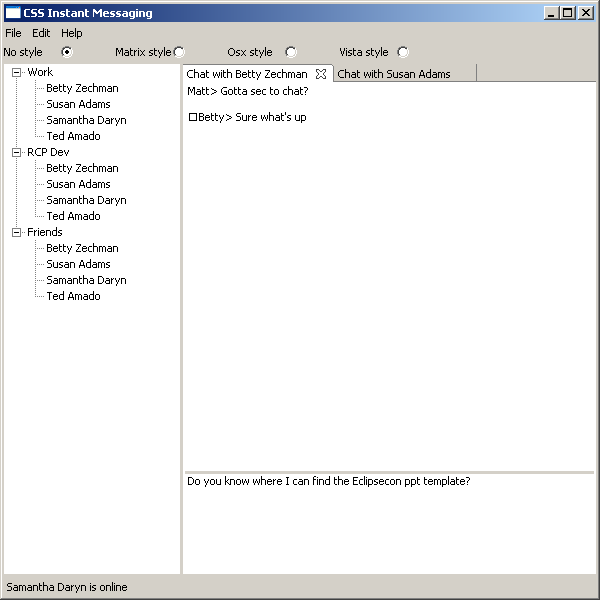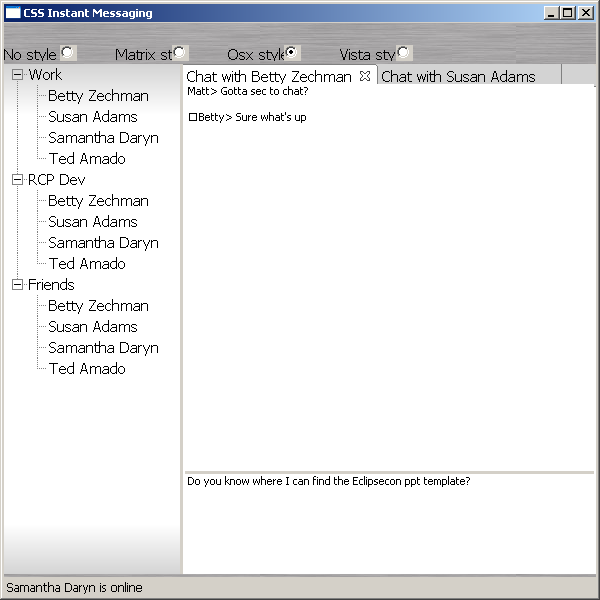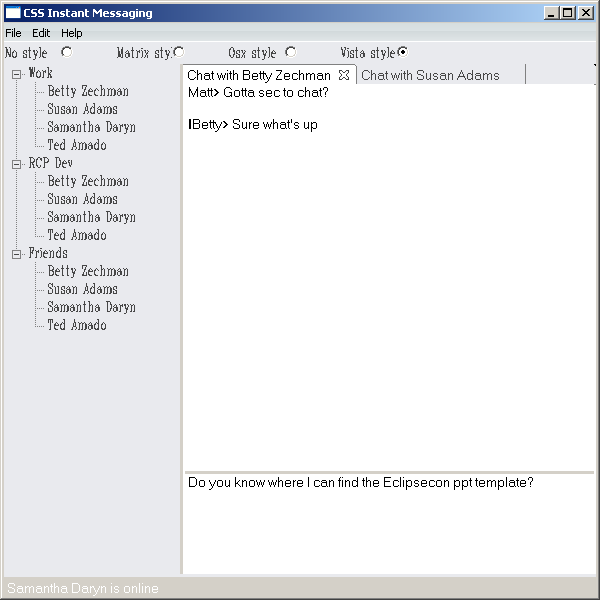

This section explain why it's interesting to use TK-UI CSS engines in your existing SWT, Swing (or others) applications :
Today user whish more and more customize her application by selecting Color, Font. CSS is used into WEB word and it is standard, powerfull way to customize WEB application. Zen Garden is a good sample which show the powerfull of CSS styles.
The 4 following screenshots show the customization of SWT Chat user interface with CSS styles. This sample comes from this article . You can find this sample into SWT distribution into org.akrogen.tkui.css.swt.examples.chat.ChatWithStylesAppliedAtRuntime Java class.
Here screenshot of SWT Chat user interface with no styles applied :

After applying Matrix.css CSS styles :
Tree, Text#output {
background-color: black;
color: white;
background: url(./images/matrix_back.jpg);
}
Text#input {
background-color: black;
color: red;
}
CTabFolder {
background-color: black;
color: white;
}
CTabFolder:selected {
background-color: green;
color: white;
font-weight: bold;
}
SashForm, Shell, Button, Label {
background-color: green;
}
ToolBar {
background-color: white, green, 100%;
color: black;
}
CLabel {
background-color: black;
color: white;
}

After applying Osx.css CSS styles :
Shell, SashForm, Button, Label {
font-family: "Lucida Grande",Serif;
font-size: 11;
background: url(./images/osx_back.jpg);
}
ToolBar, CLabel {
font-family: "Lucida Grande",Serif;
font-size: 9;
background: url(./images/osx_back.jpg);
}
Tree {
font-family: "Lucida Grande",Serif;
font-size: 11;
background-color: lightgrey, white, white, lightgrey, 10%, 90% 100%;
}
CTabFolder:selected {
background: url(./images/osx_tab.jpg);
background-color: rgb(162,208,242);
color: black;
}
CTabFolder {
font-family: "Lucida Grande",Serif;
font-size: 11;
font-weight: normal;
background-color: lightgrey;
color: black;
}

After applying Vista.css CSS styles :
Shell, Tree, Button, Label {
font-family: Roman;
font-size: 10;
background-color: rgb(233,234,238);
color: rgb(70,70,70);
}
SashForm {
background-color: black;
}
Text {
font-family: Calibri;
font-size: 10;
}
ToolBar {
background-color: gradient,
white,
white,
rgb(214,222,223),
rgb(219,226,228),
rgb(210,217,219),
rgb(224,229,231),
white,
white,
5%, 5%, 45%, 45%, 98%, 98%, 100%;
color: white;
}
CLabel {
font-family: Calibri;
font-size: 10;
background-color: gradient,
rgb(67,71,82),
rgb(59,62,70),
rgb(47,48,48),
rgb(76,76,76),
40%, 40%, 100%;
color: white;
}
CTabFolder:selected {
background: url(./images/vista_tab2.jpg);
color: white;
}
CTabFolder {
font-family: Calibri;
font-size: 10;
background-color: rgb(233,234,238);
color: rgb(70,70,70);
}
